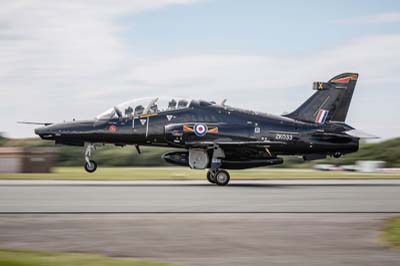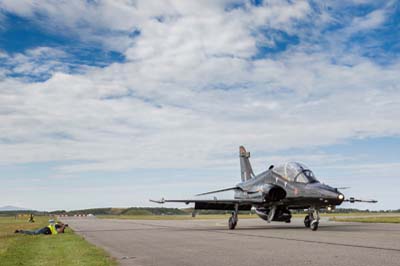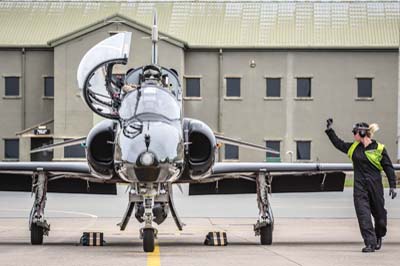PhotoPlus Apprentice - Shoot with a Pro
4(Reserve) Squadron, RAF Valley
July 21, 2016
|
 |
Moving close to the taxiway give you two interesting choice of images. This is the compressed 400mm telephoto shot make the aircraft completely fill the frame again this will reduce the effect of a dull grey sky. With the pilot giving a wave this is the image to select from the sequence. |

Philip Stevens was commissioned by PhotoPlus the Canon magazine to organise a professional photo-shoot with an apprentice jointly selected from those who wrote in requesting an aviation photography shoot with a pro. We picked Steve Whittaker to join the team which consisted of a magazine editor/writer and a staff photographer. I now had to find a suitable location for the photographic assignment, RAF Valley was a place I wanted to visit knowing it would be good for photography (if needed) from outside the base.
Getting in to RAF Valley was a challenge and I had to use all my skills and a good contact to get the visit approved by Ascent, the RAF and the MoD. The PhotoPlus 'shoot with a pro' subject, in our case aviation photography, is normally shot at an easily accessible location where the expert points out shots and the apprentice follows the advice to achieve a minimum of five 'hot shots'. It was obvious that approval would be impossible without some careful thought. I decided with the magazine's acceptance to make the shoot about photo-journalism and presented the case to Ascent along the lines of myself writing an article about Ascent Flight Training and the UK Flying Training System. Flight training operations director Alisdair Shinner welcomed my approach and after some months full approval was granted by the RAF/MoD. On the day Al Shinner did everything he could to support my numerous requests for information and photographic opportunities.
The six page article in PhotoPlus contained my Ascent/MoD approved article with supporting write-up regarding the specific advice I was gave out to my apprentice. PhotoPlus operations editor Adam Waring combined my notes with his own from the day to complete the article. I was not quite sure from the beginning if we could pull it off and meet the standards required by the magazine for this regular feature and also satisfy Ascent. In the end I think we all did a fantastic job and all parties hopefully were satisfied. For me despite having to make compromises over the text and having little control over image selection I was still very pleased with the final results. The day itself was a real pleasure working with some very enthusiastic companions under the control of the entertaining Al Shinner. Below is my contribution to the article, some of the text was edited (reduced) to suit the magazine and Ascent. |
 |
Touchdown, captured a fraction of a second after the tyres hit the runway and produce some smoke.
Set at ISO 160 to get 1/1000th of a second to freeze the action and reduce the high risk of a blurred aircraft. |
Extended article on Ascent Flight Training
 |
With the ISO knocked back to 100 and a shutter speed of 1/125th and f.11 and the background is effectively blurred to emphasize movement. After getting some safe 1/1000th second shots it was time to really test your panning skills. Although there is a high failure rate with numerous binned blurred shots if you have sufficient landings to play with it is well worth it. |
Ascent Flight Training operations director Alasdair Shinner offers an insight on how a rookie pilot becomes a top gun at RAF Valley.
Ascent Flight Training is tasked to provide the highest quality aircrew training for the Royal Air Force in the most cost effective way. Ascent is a joint venture between Lockheed Martin and Babcock International and was awarded the contract to be the Training Service Partner (TSP) to deliver the UK Military Flying Training System (UKMFTS) programme, in partnership with the Ministry of Defence, (MOD) out until 2033.
A former RAF fighter pilot Al Shinner with 3,500 hours flying experience which included operations in the Balkans, Falklands and the Gulf is fully equipped to handle the day to day challenges he faces at RAF Valley where student pilots learn to fly fast jet trainers. Students on graduation will transfer to a frontline squadron flying the Eurofighter Typhoon, supply to the older Tornado GR.4 squadrons has just about ended. Students now just starting their pilot training here could be lucky to be selected to go on to fly the world's most advanced combat aircraft, the Lockheed F-35B Lightning II.
The premise of the UKMFTS programme was to draw out efficiencies in the training pipeline without compromising on training output standards. Pilot training is costly and methods are changing as more and more technology is being introduced in to the cockpits. The analogue cockpit instrument dials that have been around for nearly a century are being replaced by digital computer screens known as 'glass cockpits' in the latest aircraft. The UKMFTS programme is procuring new aircraft with 'glass cockpits', featuring sophisticated digital displays that enable training aircraft to emulate the frontline aircraft. It is more cost effective to download training tools to training aircraft rather than use frontline aircraft for training purposes.
So how are Ascent able to reduce costs for the tax payer and yet meet the highest of standards of pilot training required by the MoD?
Pilot training is on frontline aircraft is the most costly, by downloading this training to less expensive training aircraft it has reduced costs. Another and key area where cost saving objectives are achieved is through synthetic training. Students, their instructors and the frontline pilots all regularly spend time learning or refreshing their skills 'flying' multimillion pound networks of flight simulators ranging from desktop workstations to full-mission multichannel dome simulators, in which pilots can experience what they do in the air. "The only thing it can't simulate are pulling G force when you turn hard", says Al Shinner. Simulators eliminate fuel bills, aircraft running costs, flying accidents and the many ancillary services needed to keep aircraft flying safely.
 |
The computerised digital 'glass cockpit' of the Hawk T.2 taken with the permission of the pilot at the end of his mission. The same shot was taken of an empty cockpit but that does not have the same interest. |
The UKMFTS programme is procuring new aircraft with 'glass cockpits', featuring sophisticated digital displays that enable training aircraft to emulate the frontline aircraft. It is more cost effective to download training tools to training aircraft rather than use frontline aircraft for training purposes. At RAF Valley students and their instructors fly the two-seat BAE Systems Hawk T.2 its 'glass cockpit' avionics suite provides a realistic advanced fast jet training platform. The aircraft is designed to replicate the experience of flying frontline aircraft so that the students' transition to Typhoon and F-35 Lightning II is smoother. The computerised emulation system enables complex scenarios such as air to air combat and ground attack to be simulated in the air. Virtual opponents and ground threats can be created to test the student. A Typhoon 'download' enables the student to 'see' its combat systems earlier in their flying training and at a tenth of the cost of flying the Typhoon.
UKMFTS is testament to the huge benefit and value derived from successfully run commercial contracts. Ascent works in partnership with the MOD and its purpose is to deliver world-class flying training to the UK Armed Forces.
By awarding PFI contracts the MoD are bringing in investment technology and innovation, "It's more about value for money than cost saving", explained Al Shinner. "We do more flying training here than we once did now including elements of the training previously done on the Typhoon." Students following their synthetic training arrive at the Typhoon conversion unit far better equipped to fly it than they ever did before.
At the heart of the UKMFTS programme remains a military ethos in terms of training delivery; Ascent civilian and military instructors work alongside each other in seamless partnership to deliver optimized air- and ground-based training. Ascent are really working behind the scenes, pilots at RAF Valley fly as 4(Reserve) Squadron which has its own Wing Commander in charge. "We are in the background we just enable everything to happen, the students come to a military squadron to do military training", says Al Shinner. The flying instructors are still in the RAF, the ground instructors on the simulators are with Ascent but they still where flying suits with squadron badges. They are all assessed to the same standards set by the RAF's Central Flying School. As use of the simulators forms a key part of the syllabus, it is important that ground and flying instruction is to the same standard.
Fast Jet training at RAF Valley is one element of the vast UKMFTS programme delivered by the MOD and Ascent, which is set to include Fixed Wing, Rotary Wing and Rear Crew Training, with all elements of the world-class training programme due to be fully operational by 2019.
With more modern aircraft on order such as the Beechcraft T-6 Texan II to replace the aging Shorts Tucano T.1 and will operate from RAF Valley next year, even more value for money flying training will be provided by Ascent. "There is a massive interest in what we are now providing from air forces right across the world..everyone has come here to see what we are doing", says Al Shinner.
|
 |
| With a second jet taxiing past it was time to quickly switch lenses to a 16-35mm wide angle set at 20mm and 1/500th and f.8 and ISO 160. The high shutter speed was required to prevent wing tip blur as it passes so close to the camera. With some interesting clouds and a little blue sky the low image looking up towards the control tower works well. |
 |
Two 4(R) Squadron instructor pilots walking towards the camera after completing their sortie. It looks natural does not look posed, we have positioned to get aircraft in the background. What makes the image is that one of the pilots is focused on the camera, while the other pilot is looking at him. Without the opportunity to ask the air crew to make specific poses it is important to look for natural expressions without them becoming self-conscious. |
From the photographer's point of view.
For photo-journalist type assignments it is important to find out the story that goes with the images. We started off interviewing Al Shinner using pre-prepared questions.
In shooting aircraft you always want to get the best action shots, when on base this can only be done from beside the runway for the landings and take-offs. What you must not lose sight of however are the aircrew and ground crew who really tell the story of who makes these aircraft fly. There is a choreography as servicemen perform their jobs according to set procedures and routines. The working environment is potentially dangerous unless everyone adheres to the essential safety procedures. This also means that the photographer also has to follow the given safety guidance and does not stray to get a certain shot. For example without a moving aircraft in sight our escort used his radio to ask for permission to cross an active taxiway.
 |
A 400mm telephoto lens enables you to get in close to the air crew as they taxi out for their sortie. With the instructor in the backseat looking towards the camera makes the shot becomes more personal despite his visor being down adding to his anonymous and an almost sinister stare. |
We were always looking for different locations to shoot from around the air base, elevated in the case of the control tower using a telephoto lens or perhaps lying down on the edge of the taxiway a few feet from a passing jet using a wide-angle lens. We tried not to linger too long at one location and getting the same type of shots multiple times, but moving on as soon as we could. Our escorts did not choose the locations for us, we had to keep suggesting places for them to seek permission for us to go there which was not given automatically. Anticipating action was very important to make sure you are at the right place at the right time, there's no point waiting at the end of the runway if no jets are due for an hour. Constant radio calls were made to the control tower to find out about movements.
Courtesy with an understanding of when to ask to shoot aircrew and when not to, is important. Aircrew walking to their aircraft are focused on their time critical missions should not be approached. When they return after completing their mission although exhausted are often willing to help out with some quick images before their flight debrief. Always ask before shooting pilots close-up as some pilots will not want to be photographed for security or personal reasons. Ground crew have a fast paced job to do according to time constraints so you have to stay out of their way, getting your shots as best you can. Posed shots are almost impossible to arrange, so you need to watch and learn the routines to anticipate when and where you can get the images you want. It can be fast paced for the photographer, I shot an approaching aircraft with a 400mm telephoto, switching to a 16-35mm wide-angle just in time to catch it as it taxied right past me.
Special permission was required to go on base at RAF Valley for this photo-shoot, but similar images can be taken from outside the airfield as there is a spotter car park near to the main gate and access to the four runway thresholds which offering a different perspective. Close-up shots of the air crew and ground crew are often possible from various air shows. The date for our visit was agreed months in advance and so we had to take pot luck with the weather. If you want to shoot from outside an air base study the weather looking for rain showers and storm clouds, over the winter months it is possible to get stunning sunset shots as jets recover to the airfield as the light fades. |
Left to right: The ground crew give thorough inspections of the aircraft before and after each flight. This shot was not posed but he was encouraged to hold his position as we closed in. A vignette focusses the attention on the face and hands of the technician.
A 400mm telephoto condenses/compacts the interaction between the ground crew signalling to the pilots in the aircraft. As there was a dull grey sky it is an improvement to the background with a building.
Hawk T.2 cross-over adds some extra interest. To capture both jets in the image required some anticipation of what was about to happen. Taken from the control tower the elevated position separates the two aircraft and eliminates the dull grey sky at the time. With the mission complete they have lifted their visors, but only the backseat realizes that he is being photographed from the control tower. |
 |
 |
| Left to right: PhotoPlus-Future Publishing photographer Jo Branston shooting me shooting him. Steve Whittaker aka the apprentice with the wide-angle lens belly shot. |






